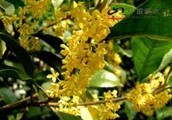Osmanthus fragrans (Sweet Osmanthus; also known as Sweet Olive, Tea Olive and Fragrant Olive) is a species of Osmanthus native to Asia, from the Himalaya east through southern China (Guizhou, Sichuan, Yunnan) and to Taiwan and to southern Japan. Sweet osmanthus is also the 'city flower' of Hangzhou, China.
It is an evergreen shrub or small tree growing to 3–12 m tall. The leaves are 7–15 cm long and 2.6–5 cm broad, with an entire or finely toothed margin. The flowers are white, pale yellow, yellow, or orange-yellow, small (1 cm long), with a four-lobed corolla 5 mm diameter, and have a strong fragrance; they are produced in small clusters in the late summer and autumn. The fruit is a purple-black drupe 10–15 mm long containing a single hard-shelled seed; it is mature in the spring about six months after flowering.
The extract of dried flowers showed neuroprotective, free radical scavenging, anti-oxidative effects in in vitro assays.
| Catalog | Product Name | CAS Number | Manual |
|---|---|---|---|
| CFN98784 | Luteolin | 491-70-3 | |
| CFN98565 | Luteolin-7-O-glucoside | 5373-11-5 | |
| CFN99272 | Quercetin | 117-39-5 | |
| CFN98850 | Quercitrin | 522-12-3 | |
| CFN97494 | Scopoletin | 92-61-5 |
A unique collection of 26 natural compounds from Cinnamomon cassia
A unique collection of 50 natural compounds from Glycyrrhiza uralensis Fisch.
A unique collection of 27 natural compounds from Saposhnikovia divaricata





